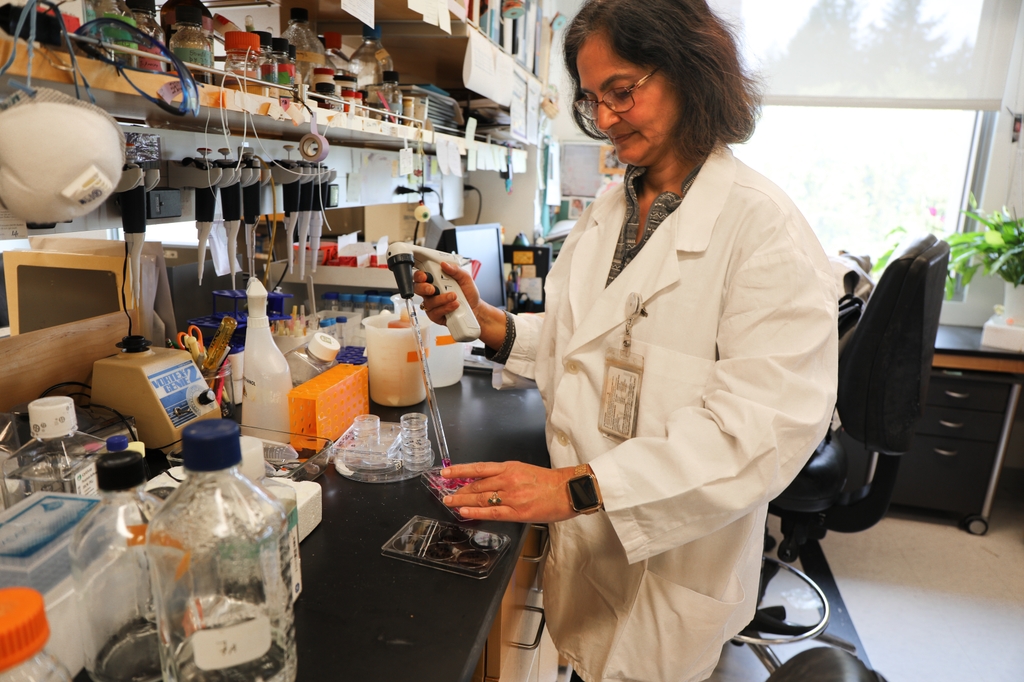
A new study on glaucoma, a leading cause of irreversible blindness, offers fresh understanding of how the disease progresses and points the way toward new treatments.

The study, published today in Cell Press, examined the behavior of cells in the eye's drainage system. The team, led by Alireza Karimi, Ph.D., assistant professor of ophthalmology and biomedical engineering in the Oregon Health & Science University School of Medicine and Casey Eye Institute, found that changes in the way the cells in the eye's drainage system respond to physical forces could be connected to the higher eye pressure seen in patients with glaucoma.
By 2040, glaucoma is expected to affect 112 million people worldwide, making it one of the most significant causes of blindness. Elevated intraocular pressure — or higher-than-normal pressure within the eye — is the primary risk factor for glaucoma, but scientists have struggled to fully understand the underlying mechanisms.
Researchers used leading-edge experimental and computational methods to study the trabecular meshwork, or TM, the part of the eye responsible for draining fluid and maintaining healthy eye pressure. The study focuses on how the stiffness of the extracellular matrix, or ECM, in the eye's outflow pathway influences the behavior of the TM cells in both healthy eyes and eyes affected by glaucoma. The ECM provides structural support to the cells, and changes in its properties have been linked to the increased pressure seen in glaucoma through an active cell-ECM interaction in the eye's outflow pathway.
The eye's drainage system has areas with low and high flow. In eyes with glaucoma, there are more areas with low flow compared with healthy eyes.
"Our goal was to understand how cells actively communicate with their ECM to regulate outflow resistance, increase outflow and thereby lower intraocular pressure," Karimi said.
The researchers found that normal TM cells respond differently to mechanical stress compared with those in eyes with glaucoma. In healthy cells, increased stiffness in the ECM led to stronger forces being exerted by the cells. However, in cells with glaucoma, the opposite occurred: Cells generated greater forces when the ECM was softer. These differences suggest that the high-flow cells affected by glaucoma are less stiff compared with high-flow normal cells; this has also been shown by atomic force microscopy.
Karimi said a major innovation in this study was the use of an experimental-computational technique to measure how the cells exert 3D contractile forces on the ECM in real time. Traditional methods used in similar studies have been limited, as they often involve detaching the cells from the ECM, which can disrupt the natural behavior of the cells. This study, however, used a more advanced approach leveraging advanced microscopy and computational techniques that allowed the researchers to continuously track the forces at play, providing a more accurate and dynamic picture of what happens in the eye over time.
Importantly, Karimi said their findings are of interest to other researchers at OHSU because the framework of how cells become stiff is also applicable in cancer research.
The next step for the research team is to develop better drug targets for glaucoma, using the framework they built for the current study. He said current treatments for glaucoma require patients to administer drops multiple times per day, which leads to skipping doses or incorrect dosages.
"We now have a framework to study targeted therapies for more effective and easier-to-administer treatments," he said, adding that his next study will look at specific drug treatments.
In addition to Karimi, OHSU coauthors on the study included Mini Aga, Ph.D., Ansel Stanik, Cristiane Franca, D.D.S., Ph.D., Elizabeth White, M.S., Mary Kelley, Ph.D., and Ted Acott, Ph.D., as well as Seyed Mohammad Siadat, Ph.D., with Northeastern University.
This research was supported by the National Eye Institute, of the National Institutes of Health, Awards R01EY036011, R01EY030238, P30EY010572, as well as the Lewis Rudin Glaucoma Prize, and Provident Bank Foundation grant to the Casey Eye Institute. The content is solely the responsibility of the authors and does not necessarily represent the official views of the NIH.






